Understanding the Benefits of Strain Gauge Technology in OEM Medical Devices and Equipment
Custom strain gauge sensing technology enhances patient experiences in everything from robotic surgical systems to mammography machines.
Introduction
In today's highly competitive medical device marketplace, original equipment manufacturers (OEMs) and their associated design and engineering personnel are opting to include custom strain gauge sensing technologies into finished product designs, as a means of achieving greater business advantage. The capability, accuracy and extended service life of such technology has been field-proven within these applications. Another measurable benefit is increased customer satisfaction in overall system performance, allowing the OEM to add that "extra competitive edge" to their bottom line, thereby increasing sales and overall "hit rate" for major contracts and projects. Strain gauge technology also contributes to drastic improvements in equipment diagnostic capabilities; a decrease in required maintenance time and costs, due to fewer field failures; and ultimately, patient care quality improvements. As such, strain gauge technology is often considered a technological "secret of success" among OEMs.
With more than 60 years of experience in the successful design, development and manufacture of custom strain gauge sensing technologies for medical devices and equipment, HBM has been an industry pioneer in this market, leveraging the capabilities of multiple global in-house manufacturing operations and the benefits of its own unique expertise, gained from hundreds of successful applications. To truly grasp the benefits of strain gauge technology, it is important to first understand the construction and operation of the strain gauge itself. This article shall provide an overview of strain gauge technology and its practical applications within medical device and equipment manufacturing; explain the typical processes by which custom strain gauge technology is introduced into medical device designs; and offer examples of device improvements achieved via successful technology integration.
Understanding the Strain Gauge
Strain gauges typically measure very small and precise mechanical strain. Consequently, changes in resistance are also very small and thus cannot be measured directly with an ohmmeter. The strain gauge, therefore, must be included in a measurement system where the precise determination of a change in resistance is possible. To do this, a Wheatstone bridge circuit must be created. The first component in the Wheatstone bridge system is formed by the strain gauge itself. It converts the mechanical strain into a change in electrical resistance.
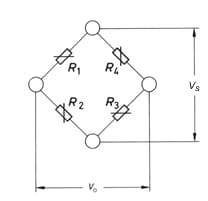
Both the strain gauge and the measuring circuit are, in the physical sense, passive components. Each strain gauge is then wired into a balanced bridge, consisting of two portions of an equal resistive value, formed into a Wheatstone bridge circuit. (HBM also constructs gauges with 1/4- and 1/2-bridge designs that require a fixed resistor to complete the Wheatstone bridge.) Regardless of bridge configuration, energy must be passed through the gauge to excite the circuit. The circuit must have an input energy source to obtain a useful signal. This auxiliary energy is taken from a separate source. Constant electrical voltage is most commonly used, though use of a constant current power source is also feasible.
When there is a change in strain gauge resistance caused by a strain and the slightest amount of change is detected, the bridge circuit loses its symmetry and becomes unbalanced. A bridge output voltage is obtained, proportional to the bridge's state of unbalance. If there is no change in the balanced resistance, the electrical output will be null, or zero. The strain gauge, on average, will measure 1/10,000 micro strain, which is enough to detect a 1-dB vibration across a 10-foot room. Thus, the measurement possibilities for various strain gauges, quite literally, have an infinite range. An amplifier must be included in the measuring process to raise the bridge output voltage to a level that is compatible with indicating instruments or monitoring computers. Sometimes, amplifiers are also designed to give an output proportional to the bridge output in voltage. HBM offers a variety of possible output options to fit individual OEM needs.
Incorporating Strain Gauge Technology into OEM Medical Devices and Equipment
The process by which design engineers incorporate strain gauge technology into medical device designs can be highly specialized. Implementation is often subject to industry or governmental regulations, both of which may directly impact final design requirements.
At HBM, after a technical briefing on the workings of the technology and customer discussions on applicable regulatory standards, an initial prototype sensor design concept is created. This process includes a detailed application analysis and recommendations for the best type of gauge to achieve intended product performance, with varied geometries, holes and cutouts, resistances, threads and other options. Using finite element analysis and other advanced engineering design tools, the appropriate location on the prototype for the strain gauge is identified. Then, the gauge is incorporated under specific operating conditions. As part of this process, the designer will strategically weaken the structural member to allow specific deflections under applied load, allowing the member to mimic the structural behavioral properties of real-use conditions. It is then calibrated and adjusted to perform a perfect, accurate and repeatable measurement. In-house testing of these parts must also be completed in accordance with industry standards and within OEM guidelines. Once a successful prototype is built, tested and accepted by the customer, it is sent to production.
HBM has the unique in-house capabilities to manufacture quantities of strain gauged parts with lead times as short as 24 hours from analysis to prototype development. Depending upon timeframe and required quantities, parts may be produced at any one of three fully staffed HBM manufacturing facilities, located in the United States, Europe and Asia. HBM can also add any required load introduction piece, with additional in-house testing capabilities to ensure the design, development and performance of an accurate subassembly.
A medical device OEM may also opt to self-manufacture finished sensors from a gauged prototype part. However, the strategic benefits of a strain gauge manufacturer's own in-house expertise allows a customer to have complete assurances in the quality and uniformity of manufactured sensors. Each sensor is tested according to the same rigorous in-house standards as the initial prototype, and the supplier is committed to the accuracy and reliability of the critical component and its timely delivery to meet device manufacturing schedules. This mitigation of in-house production risk ultimately can save the device manufacturer valuable time, cost and resources.
Successful Applications
Custom strain gauge technology is used in both critical and non-critical medical device and equipment applications, ranging from high-precision robotic surgery to patient scale weight distribution and medical pump pressure and flow measurements. Some general examples of the hundreds of successful strain gauge technology applications developed by HBM include:
Non-Invasive Medical Imaging and Diagnostic Equipment
CT scan Machines
CT scan machines require highly repeatable table positioning, as well as equal patient weight distribution and precision movement of the CT scan imaging device. Precision is required in order to perform high-accuracy imaging functions while preventing over-travel of the patient placed within the scanning tube. Within this environment, the incorporation of a multi-axis strain gauged subassembly has proven to be an effective means of better ensuring the smooth, consistent movement and positioning of the table while adjusting for weight distribution. These design enhancements, created by the successful incorporation of HBM strain gauge technology, have facilitated the manufacture of more accurate medical diagnostic imaging machinery.
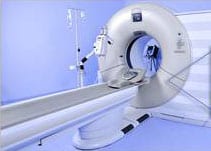
Mammography Machines
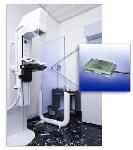
As noninvasive medical imaging diagnostic tools, mammography machines are among the medical community's most commonly used equipment for detecting breast tumors and related conditions. For this type of application, a medical equipment OEM required a means of monitoring the amount of physical force that is applied to the patient by the machine itself when attempting to take an image. The proposed customer solution had to allow for the highest possible image resolution while maintaining patient position and comfort and preventing machinery over-travel. This application challenge was solved by the use of both dual and triaxial strain gauge force sensors with the incorporation of a redundant multi-axis sensor. The sensors were mounted on the top and bottom clamp of the mammography machine, forming a flat item scale to monitor machinery flexure; a mechanical stop was incorporated to prevent machinery over-travel and measurement redundancy. As a result, the OEM was able to introduce mammography machinery design improvements that offered more accurate positioning, better patient comfort and enhanced image resolution. Other successful medical machinery position and motion applications of HBM strain gauge technology include operating table adjustments, chiropractic beds and dental surgery chairs.
Weight Distribution Applications
Patient Lift Systems
Motorized lift systems are a common means of moving or transferring patients from their beds into wheelchairs or gurneys, as well as turning patients to minimize the potential for development of pneumonia or pressure ulcers. A system consists of a handle device installed at a patient's bedside, which is pulled to activate motorized movement upon demand. For this custom application requirement, a major medical equipment OEM approached HBM for a better means of properly monitoring weight distribution, center of gravity and the speed and consistency of motorized lifting movements. By incorporating a custom strain gauge force sensing assembly within the lift system bed handle, the OEM was able to achieve better control over system rate of movement: by applying a proportional amount of force to the handle, the medical professional affects the lift speed of the device in a user-friendly manner.
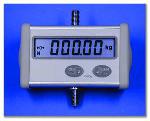
Medical Weighing
Medical scale assemblies, such as those required for pediatrics, veterinary medicine, home health monitoring and pharmaceutical use, are all examples of medical OEM applications that successfully incorporate HBM custom strain gauge technology. Highly varied requirements of this type range from subassemblies capable of measuring nanostrain or other values to a fraction of a gram, to weighing systems measuring up to 500 lbf. A recent example of a successful OEM medical weighing application developed at HBM is the incorporation of a load cell into a metal plate on a baby scale. HBM manufactured the subassembly and the customer simply supplied the top plate to form an entire scale.
Minimally Invasive Medical Devices
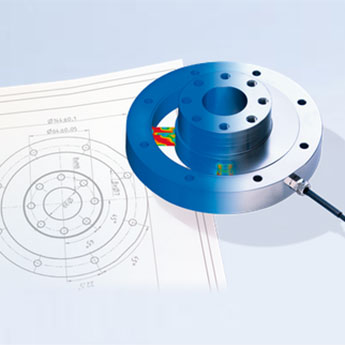
Remote Robotics Surgeries
A recent trend within the Asia Pacific medical community has been the adoption of robotic methodologies for orthopedic surgery. In this type of application, a physician remotely operates on a patient, while maintaining the same levels of precision and accuracy as an onsite surgical procedure. To keep pace with demand for new robotic surgical equipment, a major medical equipment OEM needed to be able to accurately measure both depth of force and drill bit rotational force during remote hip surgeries. The manufacturer needed to accurately assess how far into the bone to drill on an X-, Y-, and Z-axis, while still maintaining repeatable and accurate positioning of the drill bit. Positioning in this context refers to the in and out twisting motion of the drill, indicative of a rotational torque measurement, with manufactured accuracy requirements in the tens of thousandths of an inch. To address these highly challenging application requirements, HBM designed and manufactured a series of multi-axis custom strain gauge sensor subassemblies in both compression and tension modes to measure downward and upward force and motion. Another strain gauge sensor was mounted in a perpendicular configuration to measure full deflection and drilling motion consistency, ensuring patient positioning on the operating table. As a result, the medical equipment OEM was able to introduce a high-precision robotic surgical device with greater accuracy and performance capabilities.
Medical Pumps
Insulin Pump Fluid Flow Monitoring
For fluid flow monitoring, a medical device OEM approached HBM to develop a strain gauge to monitor and control the fluid output of an insulin pump. The pump is designed for on-body continuous patient use, to provide insulin incrementally as determined by feedback from an integral continuous blood glucose monitor, with the added requirement for a patient to be able to override as needed for therapies upon demand. The application environment itself is highly compact and would be subject to the ongoing shock and vibration inputs of normal patient use. Thus, a highly rugged, precise and lightweight strain gauge sensing technology was required. For this application, HBM designed and developed a unique subminiature strain gauge sensor assembly, positioned and strategically weakened to allow for both manual and automatic control of insulin delivery. The successful integration of this technology has led to the incorporation of strain gauge sensors as an industry standard for many of the world's leading insulin pump manufacturers.
Medical Infusion Pumps/Syringe Pumps
For fluid flow monitoring of a medical infusion pump, HBM developed a series of strain gauges to monitor and control fluid flow of intravenous medication that was to be received via the tubing clamp. The device design had to allow for uniform fluid delivery without coming into contact with the fluid itself. For this application, HBM designed and developed a unique 1.5 lbf strain gauge sensor assembly, positioned and strategically weakened to form a blade-shaped configuration. With its blade shape, the assembly mimics the behavior of a perfect spring, returning to zero when liquid stops flowing, for highly repeatable performance and non-contact with the fluids themselves. The sensors were applied in several strategic locations of the pump and also on the tubing clamp, allowing the device to measure not only the weight of the fluid, but also to sense increased fluid loss or an empty bag, signaling the need for replacement, as well as any potential interference of the continuous flow caused by external factors, such as the tangling of a tube line or vein blockages. Use of this specific technology has been adopted by numerous pump OEMs in various formats as a cost-effective means of monitoring and controlling critical liquid flow for intravenous anesthesia, pain management therapy and blood transfusion equipment, meeting both in-hospital and outpatient care requirements.
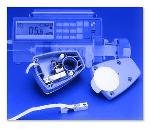
Kidney Dialysis Machines
Kidney dialysis machines incorporate strain gauge sensing technologies to ensure uniform fluid flow and circulation of proper rate, proportion and frequency according to the parameters set by its accompanying electronic controller device. Timing within this flow measurement system is of critical patient importance, to ensure that as blood leaves the body and is filtered, the recirculation process occurs in a synergistic timeframe. In these applications, strain gauged parts are used to monitor not only medical pumps, but also the weight of canisters of both blood and waste and flow of hanging intravenous fluids, all with the goal of ensuring consistent therapy delivery. Typically, data from these sensors are used by the electronic controller device managing the dialysis process. For this application, HBM has designed a variety of custom strain gauge sensor assemblies, with accompanying load cell technologies for canister weight and measurement. With this comprehensive technology integration, the OEM was able to ensure that both pumps and canister systems incorporated the necessary checks and balances to ensure smooth running dialysis processes.
Conclusion
With its relatively simple construction, OEM incorporation of HBM custom strain gauge technology into medical devices and equipment presents many advantages. The relatively low-cost design of the strain gauge offers high accuracy and repeatability for seamless integration into a variety of non-invasive and minimally invasive device designs. The extensive capability of the strain gauge for modification to meet specific customer measurement requirements facilitates its growing use within the industry. With more than 60 years of expertise across hundreds of applications, the team at HBM understands the market and its associated challenges. Through its unique global manufacturing capabilities to develop OEM strain gauged parts, with prototype turnarounds in as few as 24 hours, HBM continuously presents a growing number of highly satisfied medical device and equipment customers with new options to improve design efficiencies and performance.
Author:
Robert Chevalier
Director of Sensor Sales, Americas
HBM

Contact Our OEM Sensor Team
Contact our experienced team of design engineers for more information and to discuss your project needs.